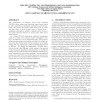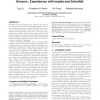MOBISYS
2004
ACM
15 years 2 months ago
2004
ACM
We study the problem of tracking a moving device under two indoor location architectures: an active mobile architecture and a passive mobile architecture. In the former, the infra...
MOBISYS
2004
ACM
15 years 2 months ago
2004
ACM
The 802.11 IEEE Standard has enabled low cost and effective wireless LAN services (WLAN). With the sales and deployment of WLAN based networks exploding, many people believe that ...
MOBISYS
2004
ACM
15 years 2 months ago
2004
ACM
This paper discusses the software architecture of Impromptu, a mobile IP-based audio computing platform, with an associated set of network-based applications and services. Impromp...
MOBISYS
2004
ACM
15 years 2 months ago
2004
ACM
The amount of personal digital media is increasing, and managing it has become a pressing problem. Effective management of media content is not possible without content-related me...
MOBISYS
2004
ACM
15 years 2 months ago
2004
ACM
Many approaches exist today that address the issues that arise when a mobile node changes its point(s) of attachment to the Internet. Mobile IP takes care of host mobility at the ...
MOBISYS
2004
ACM
15 years 2 months ago
2004
ACM
The performance of Wireless Local Area Networks (WLANs) often suffers from link-layer frame losses caused by noise, interference, multipath, attenuation, and user mobility. We obs...
MOBISYS
2004
ACM
15 years 2 months ago
2004
ACM
ZebraNet is a mobile, wireless sensor network in which nodes move throughout an environment working to gather and process information about their surroundings [10]. As in many sen...
MOBISYS
2004
ACM
15 years 2 months ago
2004
ACM
Privacy is the most often-cited criticism of ubiquitous computing, and may be the greatest barrier to its long-term success. However, developers currently have little support in d...
MOBISYS
2004
ACM
15 years 2 months ago
2004
ACM
The focus of surveillance missions is to acquire and verify information about enemy capabilities and positions of hostile targets. Such missions often involve a high element of ri...
MOBISYS
2004
ACM
15 years 2 months ago
2004
ACM
Computation off-loading, i.e., remote execution, has been shown to be effective for extending the computational power and battery life of resource-restricted devices, e.g., hand-h...




